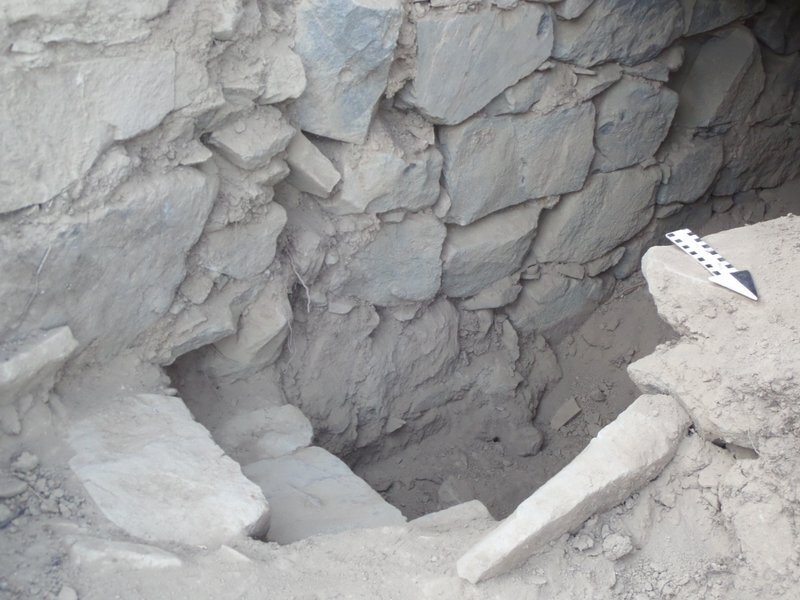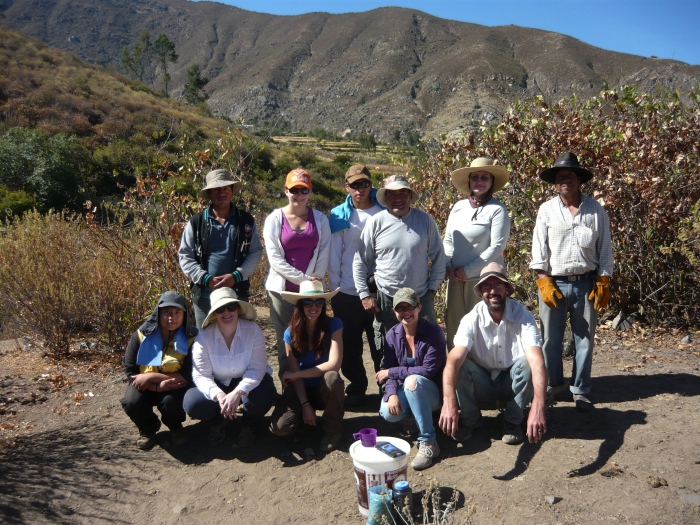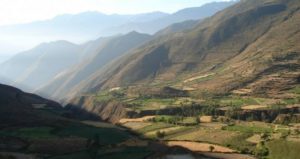
Cáceres District, Nepeña Valley, Peru—Nestled within a basin and surrounded on three sides by ridges of the Cordillera Negra Mountains of north-central Peru, the tiny village of Cosma stands out with rows of pastel colored, closely-packed buildings—teal, yellow, white, lime-green, red—an assortment of colors that many in the U.S. might associate with a beach town. It closely connects to another small settlement known as Collique. Separated only by a five-minute walk on a dirt road, together these villages total only about 80 people; and much like many other small rural communities in this part of Peru, the people here are mostly farmers and pastoralists—their richly cultivated lots and fields can be seen nearby. But recently they have been playing host to a small team of archaeologists, students and volunteers who are excavating evidence of a civilization that left its mark here perhaps more than 3,000 years ago.
It began almost by accident.
A Fortuitous Discovery
“I was revisiting prehistoric sites in the upper Nepeña Valley originally surveyed by Richard Daggett and Donald Proulx in the 1970s,” says Kimberly Munro, an Andean archaeologist and PhD student in Geography and Anthropology at Louisiana State University. Munro has been excavating and conducting research in Peru, primarily in the highland areas. “These sites were mostly ridge-top occupations, and based on Daggett’s report, showed evidence of highland-coastal interaction; a topic of interest for me for my own dissertation research.” A local school principal from the town of Salitre clued her in to a “large Inca site and a hilltop fortress known as Iglesia Hirca” near Cosma. She decided to explore the tip.
“There is no public transport up the mountain to the town of Cosma, so we had to hitch a ride with the delivery truck that goes up once a week with the community’s supplies,” said Munro. “We were riding up on the top of the truck and when it took that last bend in the road before Cosma, I caught a glimpse of Karecoto [the local name of a large mound] for the first time—and honestly couldn’t believe what I was seeing. I knew it wasn’t natural, or Inca, and its massive size and composition was reminiscent of [ancient Peruvian] highland centers. Even though we were in the upper reaches of the coastal valley, we were still in a coastal valley, and this was something different from what we had seen throughout the rest of Nepeña.”
What Munro saw was actually one of several ancient sites that, together, bespoke a possible associated complex of structures with beginnings at least as long ago as ancient Peru’s “Early Horizon” period (900 – 1 BCE). She knew this after her inspection of the mounds and survey of surface ceramics and other finds at the sites during the summer of 2013: “From the density and styles of the ceramics, and the different archaeological components, I believe Cosma has been continuously occupied since at least the Early Horizon.”
The largest of the three mounds in the complex, Karecoto, measures about 250 meters long and 70 meters wide, and features an underground gallery and truncated top. The top is flat, and Munro describes its location as including walls and domestic structures surrounded by what appear to be prehistoric canals. About 600 meters south of the large mound and across a ravine is a smaller mound, known as Ashipucoto, which features signs of exposed architecture at its top due to looting. Above Ashipucoto to the south is a ridgeline that supports what is interpreted as the domestic area of the site and, following the ridgeline about 1,000 meters up is an Inca occupation known as Caja Rumi, which features large boulders, more ancient terraces, and more domestic walls and architecture. Finally, perched atop an opposite ridge overlooking Karecoto and the village of Cosma is the third mound known as Kunka, and Iglesia Hirca, a hilltop fortress-like structure. The three mounds, excluding the Inca occupations, are tentatively dated by Munro to the Early Horizon Period.
______________________________________
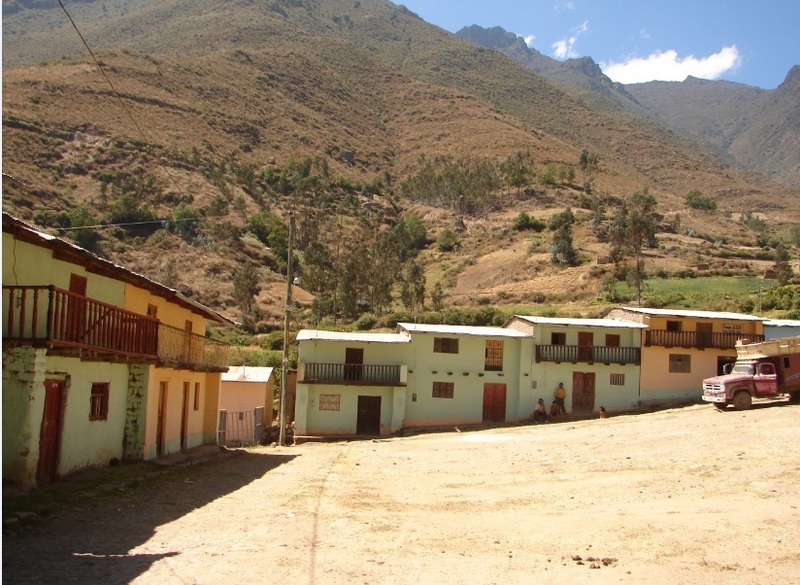 The town of Cosma, with the Cordillera Negra mountains in the background. The town has early 18th century Spanish colonial origins. It is listed by the district municipality as being “the oldest town in the department of Ancash.” Photo credit Kimberly Munro.
The town of Cosma, with the Cordillera Negra mountains in the background. The town has early 18th century Spanish colonial origins. It is listed by the district municipality as being “the oldest town in the department of Ancash.” Photo credit Kimberly Munro.
 The Nepeña river, Nepeña valley, and the Cosma location (right of center) in this image, with map inset showing Cosma location within the Cáceres District, Department of Ancash, north-central Peru. Image credit Kimberly Munro.
The Nepeña river, Nepeña valley, and the Cosma location (right of center) in this image, with map inset showing Cosma location within the Cáceres District, Department of Ancash, north-central Peru. Image credit Kimberly Munro.
 Map of the basin with all major site elements, including the villages of Cosma and Collique. Courtesy Kimberly Munro and the Cosma Archaeological Project
Map of the basin with all major site elements, including the villages of Cosma and Collique. Courtesy Kimberly Munro and the Cosma Archaeological Project
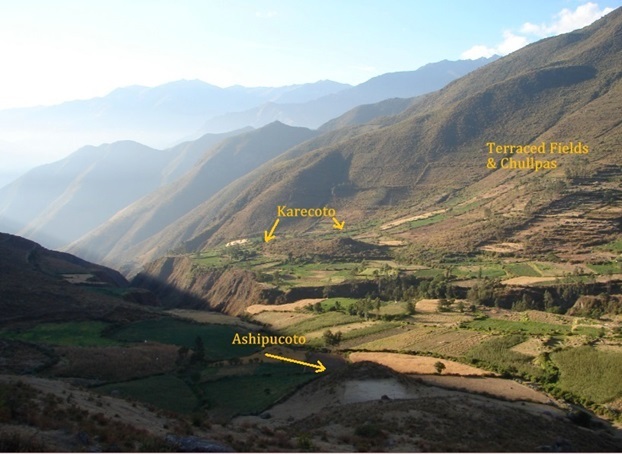 View of the Karecoto and Ashipucoto mounds relative to each other within the research area. Photo credit Kimberly Munro.
View of the Karecoto and Ashipucoto mounds relative to each other within the research area. Photo credit Kimberly Munro.
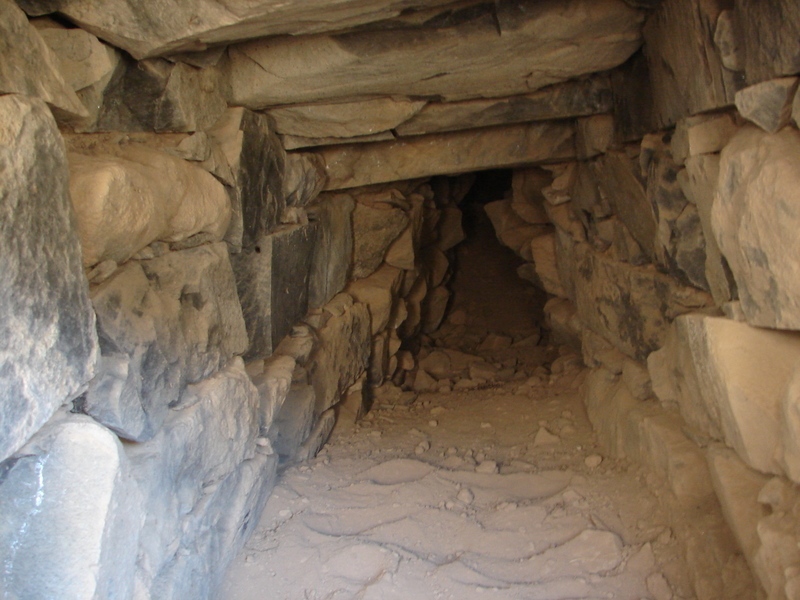 Interior view of the Karecoto mound gallery. Photo credit Kimbery Munro.
Interior view of the Karecoto mound gallery. Photo credit Kimbery Munro.
__________________________
Excavation
The Cosma complex holds great interest for Munro, not only because of its buried structures and artifacts, but because of what it could mean for a better understanding of ancient Peruvian lifestyles and sociocultural dynamics.
“Cosma is located in an ecological region which has largely been ignored by researchers,” Munro says. “When people have looked at highland-coastal interactions, they typically have focused on either end of the spectrum, either by studying coastal sites or sites located within high altitude basins.” The Cosma sites, because of their location in the upper reaches of the coastal river valley, could offer a glimpse into ancient inter-regional interactions that many other sites could not afford.
Teaming up with Lic. Jeisen Navarro, a professional Peruvian archaeologist and co-director of the new project, and Dr. David Chicoine of Louisiana State University, Munro began the first excavation season in earnest during the summer of 2014.
It was not easy.
“Cosma is just physically hard to get to,” said Munro. “There is no public transportation, so organizing the logistics of field work and arranging to get supplies and the crew up to the site was a challenge.” Initial access and then going from one location to another within the area of investigation meant negotiating steep mountainous terrain. The excavation sites were overgrown with cacti and bushes, which, at first, would not be an unusual condition for an archaeological site. But this team was small. They needed help from the local community. The villagers warmly obliged, and it cut the initial clearing operation time from perhaps several weeks to only one.
Once they had the clearing behind them, the team began cleaning off architecture that had been previously exposed at the Karecoto and Ashipucoto mounds by looters’ pits. This gave clues about each of the mounds’ architectural elements and where the excavators could set their first test pits and excavation units. Three test pits and five full excavation units were opened up at Karecoto. Later, they were also able to open up one excavation unit at Ashipucoto.
“The main purpose of the first season was to establish a site chronology,” Munro continued. “We wanted to see the dates of the ceremonial mounds and whether they were utilized or built contemporaneously, or if they were each built and occupied during different time periods. We also wanted to get a good understanding of the spatial and architectural elements of the mounds in order to better understand the complexity of the site. We spent a good deal of time mapping with a total station, and hiking around the area/hillsides to GPS the architecture and tombs which we couldn’t reach with a total station.”
As excavation progressed, the picture of the mounds began to emerge, along with a few surprises. They found that the underground gallery at Karecoto, the big mound, features stairs leading down into the gallery opening. The top-most portion or phase of the mound was apparently constructed as a circular platform and wall. Within the mound was evidence of another, smaller, circular wall. As test pit results showed, it appeared that the circular platform and the built-up general platform upon which it was constructed were both contemporaneous, having been built and utilized during the same time period. The overall structure of Karecoto ws beginning to come into focus. As co-director Navarro-Vega described it: “Think of Karecoto like a cake resting on a table, and there are three different levels total. The first is the long built-up platform, which measures 250 meters in length but only a few meters high. That could be compared to the “table” the cake is resting on. Then there is the built-up mound proper, which at its peak is 18 meters in height. This is a two-tiered cake. The bottom level is wider, and fatter, and could serve more people. The top level is the small circular platform we recorded and where the underground gallery is located.”
But perhaps the biggest developments came at Ashipucoto. Here, the team uncovered a large circular room with a diameter of about 6 meters. “The architecture was spectacular, with smoothed/worked stones comprising a wall that was over 7ft high,” said Munro. “We also discovered intrusive tombs from the Late Intermediate Period (1100- 1470 CE) dug into the mound construction—which was originally constructed much earlier—during at least the Early Horizon (900-200 BCE).” The excavators found that the room appeared to have been purposely filled with small rocks and then covered with a hard compact clay fill. “Not a single artifact was found in our excavations of the room fill, so it’s possible this was an area which was ritually cleaned before the room was sealed off,” continued Munro. “The intrusive burials on Ashipucoto are also intriguing since they illustrate the continuous occupation at the site over millennia.” Associated with the burials were fineware vessels like Chimú pottery and face-neck vessel jars, objects thought to originate from coastal areas. The Chimú culture arose around 900 CE and influenced Nepeña from about 1100 to 1470 CE (the Late Intermediate Period). More broadly, the Chimu Empire conquered the central and north coast of Peru between the Pacific and the western slopes of the Andes. Said Munro, “this is different from Karecoto, where it appears that at least on the mound proper, activity and use stopped by the Early Horizon” as much as a millennium before.
Another major find: The three mounds, Karecoto, Ashipucoto, and Kunka, appear to be aligned in a north-south direction. Although they already suspected this based on satellite imagery and images from the 2013 survey, on-the-ground mapping during the first full excavation season confirmed it. “The line is just 3 degrees west of a N-S axis,” Munro stated. What was the significance of this alignment to the ancient Cosmenos, the people of Cosma who lived here so long ago? The question will no doubt anchor further research.
________________________________________
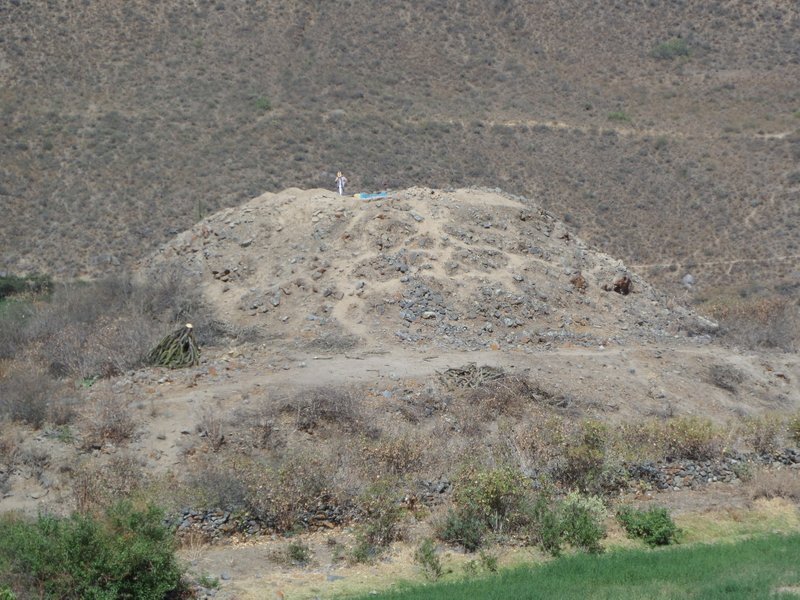 Profile view of the main mound of Karecoto. Photo credit Kimberly Munro.
Profile view of the main mound of Karecoto. Photo credit Kimberly Munro.
 Field crew excavating on Karecoto. Note vegetation overgrown on Kareocoto platform. Photo credit Kimberly Munro.
Field crew excavating on Karecoto. Note vegetation overgrown on Kareocoto platform. Photo credit Kimberly Munro.
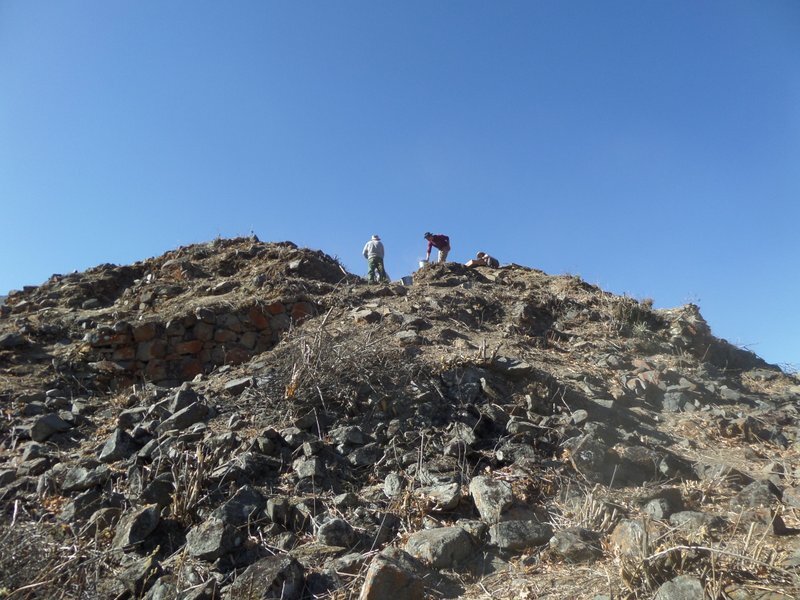 Exposed section of wall and archaeologists Jeisen Navarro and Craig Dengel excavating on top of Karecoto mound. Photo credit Kimberly Munro.
Exposed section of wall and archaeologists Jeisen Navarro and Craig Dengel excavating on top of Karecoto mound. Photo credit Kimberly Munro.
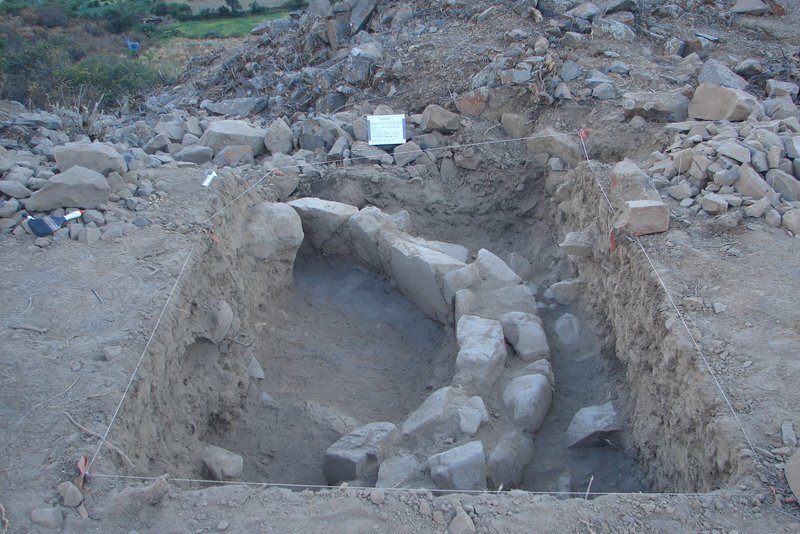 The interior wall/room excavated on Karecoto. Photo credit Kimberly Munro.
The interior wall/room excavated on Karecoto. Photo credit Kimberly Munro.
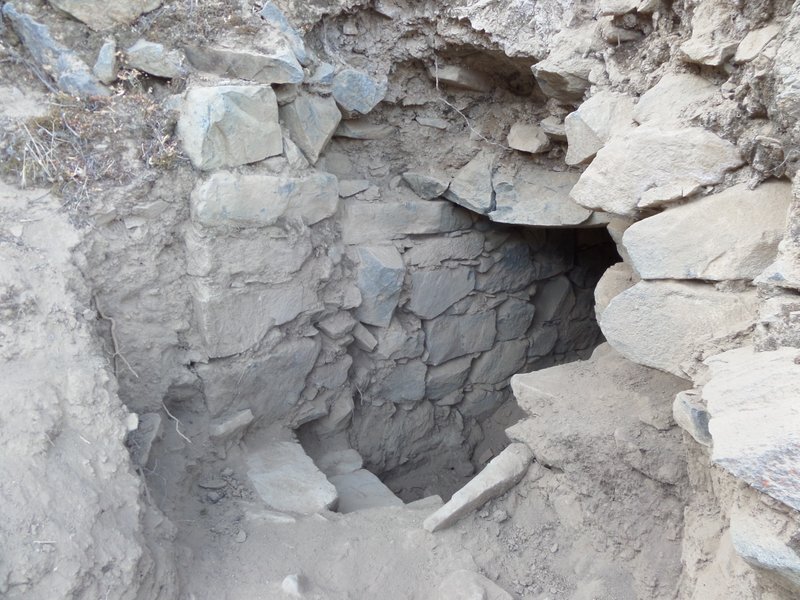 Above and below: Stairway leading into gallery within Karecoto. Photo credit Kimberly Munro.
Above and below: Stairway leading into gallery within Karecoto. Photo credit Kimberly Munro.
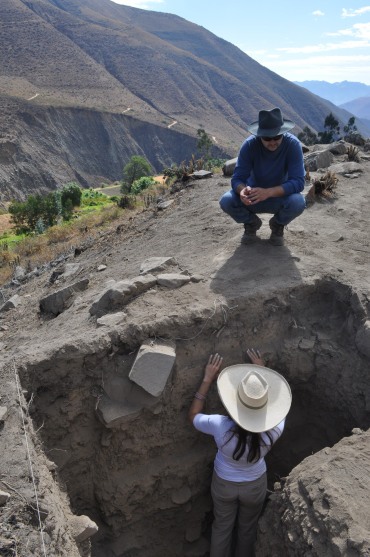 Prepared floors in the profile of a test pit. Courtesy Cosma Archaeological Project.
Prepared floors in the profile of a test pit. Courtesy Cosma Archaeological Project.
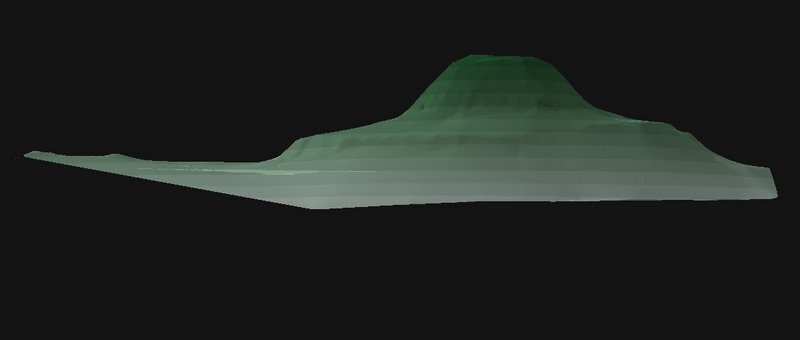 3D imaging of Karecoto made from total station points collected during the 2014 season. Courtesy Kimberly Munro and the Cosma Archaeological Project.
3D imaging of Karecoto made from total station points collected during the 2014 season. Courtesy Kimberly Munro and the Cosma Archaeological Project.
 Ashipucoto (foreground with soccer field) and Karecoto on the landscape. Photo credit Kimberly Munro.
Ashipucoto (foreground with soccer field) and Karecoto on the landscape. Photo credit Kimberly Munro.
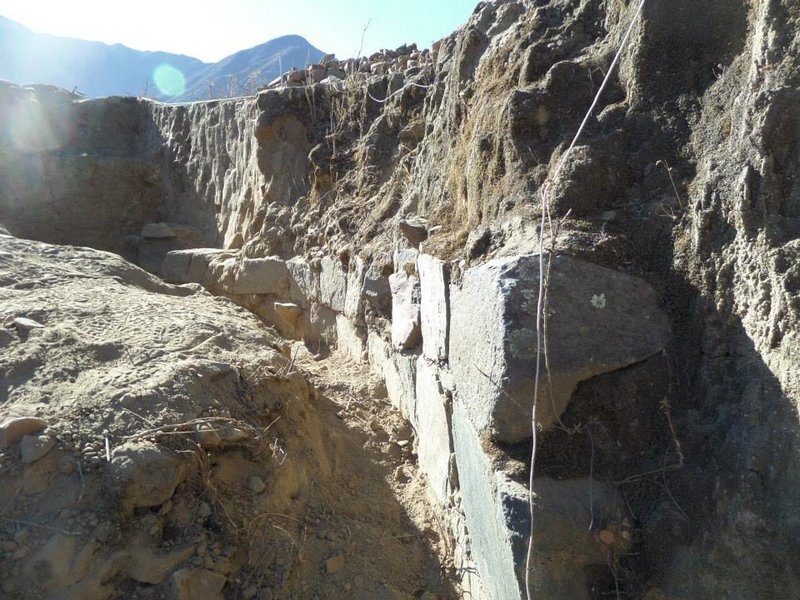 Wall of the circular room within Ashipucoto revealed. Photo credit Kimberly Munro.
Wall of the circular room within Ashipucoto revealed. Photo credit Kimberly Munro.
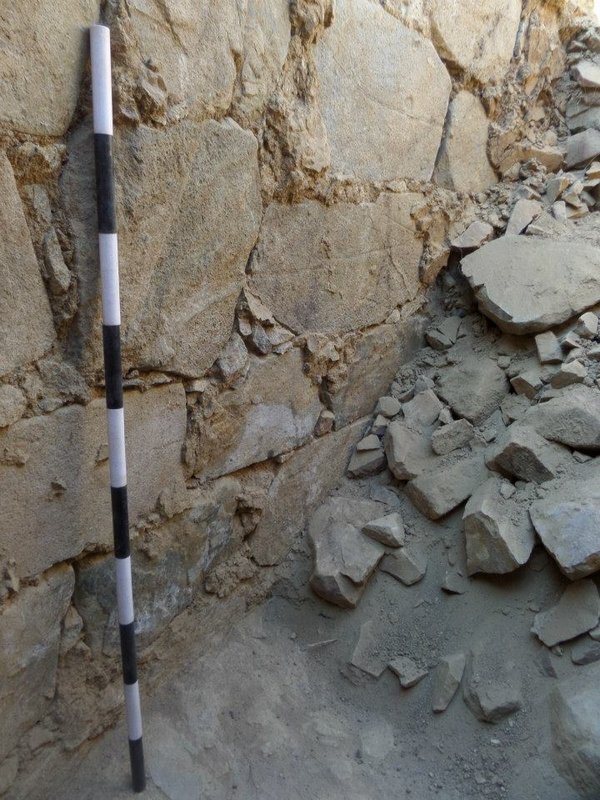 Detailed view of circular room wall at Ashipucoto. Photo credit Kimberly Munro.
Detailed view of circular room wall at Ashipucoto. Photo credit Kimberly Munro.
 Archaeologist and project co-director Jeisen Navarro mapping the interior circular room in Ashipucoto. Photo credit Kimberly Munro.
Archaeologist and project co-director Jeisen Navarro mapping the interior circular room in Ashipucoto. Photo credit Kimberly Munro.
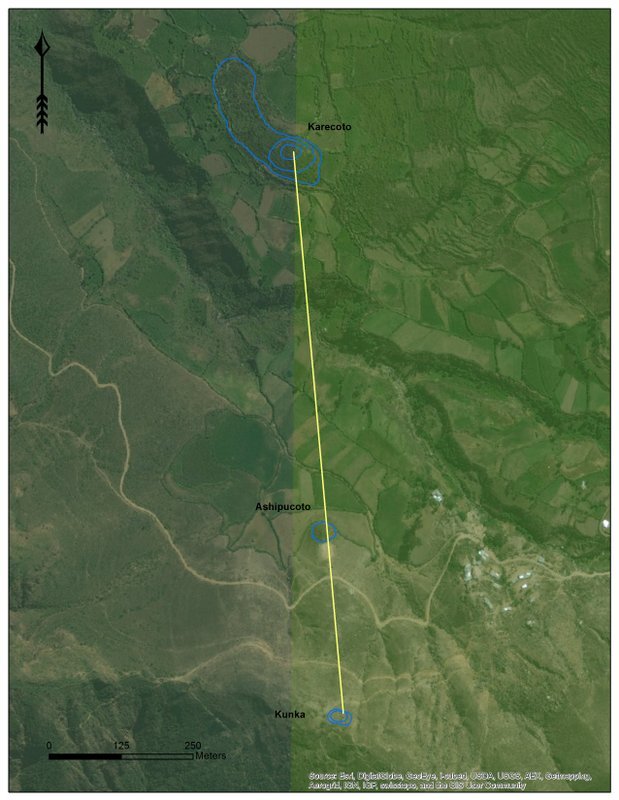 The mounds align on a nearly north-south axis. Courtesy Kimberly Munro and the Cosma Archaeological Project.
The mounds align on a nearly north-south axis. Courtesy Kimberly Munro and the Cosma Archaeological Project.
__________________________________________________
Looking Ahead
The end of the 2014 season barely made a dent in what the Cosma team still had before them—a complex of ceremonial mounds, domestic structures, burials, and other features that altogether likely span a period of over 3,000 years, most of which still remains hidden beneath overgrowth and soil. But it was an auspicious start.
“Plans for next year are to expand our excavations at Karecoto,” says Munro. “I’d like to put in a larger trench to see if we can locate the stairway up the mound summit, and the end of the underground gallery. Our 2014 findings have shown us that Karecoto was mainly utilized during the Initial Period (1800/1500 BCE – 900 BCE) and Early Horizon, and the final capping episode on the mound summit happened during the Early Horizon. We located two separate floor levels, but due to the soil composition, which is very compact, very hard clay, we were only able to get down 9 feet within Karecoto. The mound was mapped at 18 meters high. So our understanding of the complexity of this structure is still very minimal.“
At Ashipucoto, Munro and colleagues want to continue excavating the circular room to identify internal elements and features and recover artifacts. Because this room was found on the west side of the mound, the team also has plans to excavate another large unit on the other side of the mound to determine if there are any other rooms or structures.
For the third mound, Kunka, time simply ran out. It remains relatively unexplored. But in 2015, they plan to dig a test pit there to establish the chronology. “Surface artifacts and architecture initially made us believe this mound is of later construction (Early Intermediate Period), but we won’t know for sure till we are able to peel back the layers of the mound,” says Munro.
Ultimately the researchers want to expand on the work here to develop an understanding of the nature and complexity of inter-regional interactions in the upper Nepeña valley, the overall geographic context of the Cosma sites. Cosma will be a key to developing this understanding, not the least of which is the alluring mystery of its location: “The site is located in an isolated area that is hard to reach. Why was a major monumental center constructed in that area instead of along one of the major prehistoric trade routes of the valley?” asks Munro. The key might rest within the bigger picture of what was happening here in terms of the sociocultural dynamics. “I’d really like to help shed light on intermediary zones and their importance within larger scale politics and interaction networks.”
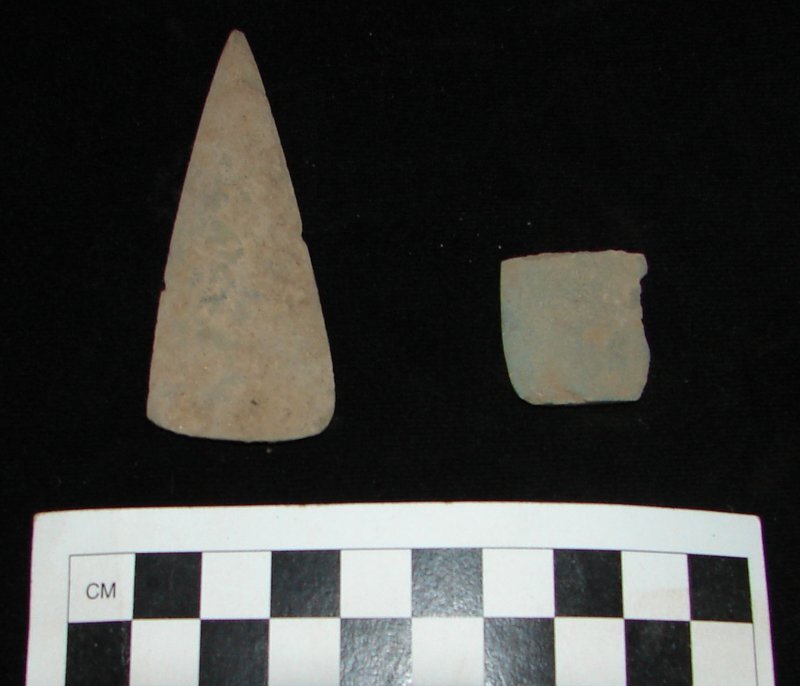 Stone points found during excavations at Karecoto. Courtesy Kimberly Munro and the Cosma Archaeological Project.
Stone points found during excavations at Karecoto. Courtesy Kimberly Munro and the Cosma Archaeological Project.
 Ceramic effigy fragment recovered from Ashipucoto. Courtesy Kimberly Munro and the Cosma Archaeological Project.
Ceramic effigy fragment recovered from Ashipucoto. Courtesy Kimberly Munro and the Cosma Archaeological Project.
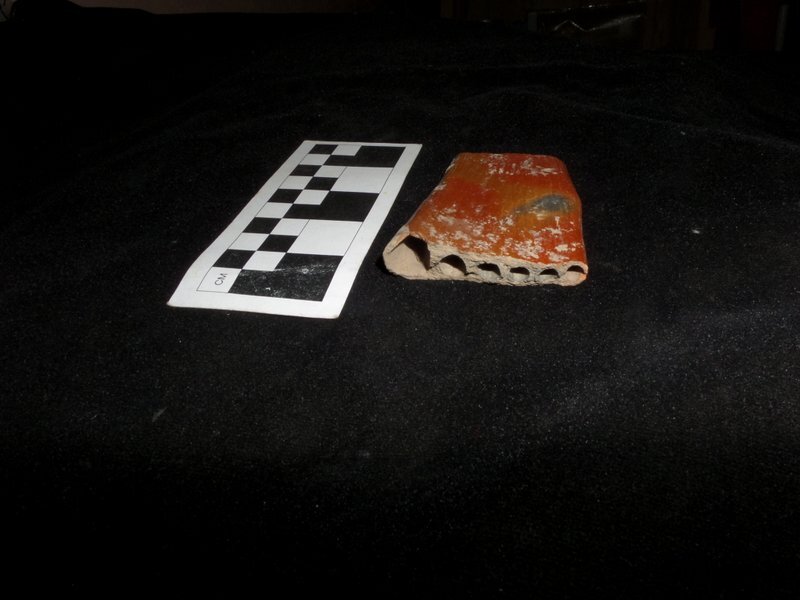 Ceramic panpipe fragment recovered from Karecoto. Courtesy Kimberly Munro and the Cosma Archaeological Project.
Ceramic panpipe fragment recovered from Karecoto. Courtesy Kimberly Munro and the Cosma Archaeological Project.
Chimú face-neck vessel shown to team by local community member, originally recovered from Ashipucoto. Courtesy Kimberly Munro and the Cosma Archaeological Project.
____________________________________________________
Readers who are interested in learning more about the Cosma Archaeological Project or who desire to participate in the excavations are encouraged to go to the project website.
The Cosma Archaeological Project has also partnered with the local community leaders in Cosma to provide medicines, school supplies, dental care products, and funding for community development projects, such as repairing buildings, creating irrigation canals, and installing bathrooms and showers. Go to this website for more information and to donate.
_______________________________________
The Cosma Archaeological Project Field Team
 Project Co-Director Kimberly Munro
Project Co-Director Kimberly Munro
Kimberly Munro is a PhD student at Louisiana State University. She has seven years of Cultural Resources Management (CRM) experience working for the United States Forest Service and the National Park Service. She also has spent five field seasons in the Andes, primarily on the north coast of Peru and the Peruvian central highlands. She has worked as an instructor both in the field and in the classroom, and plans to continue long-term investigations of the complexity of inter-regional interactions in the upper Nepeña River Valley.
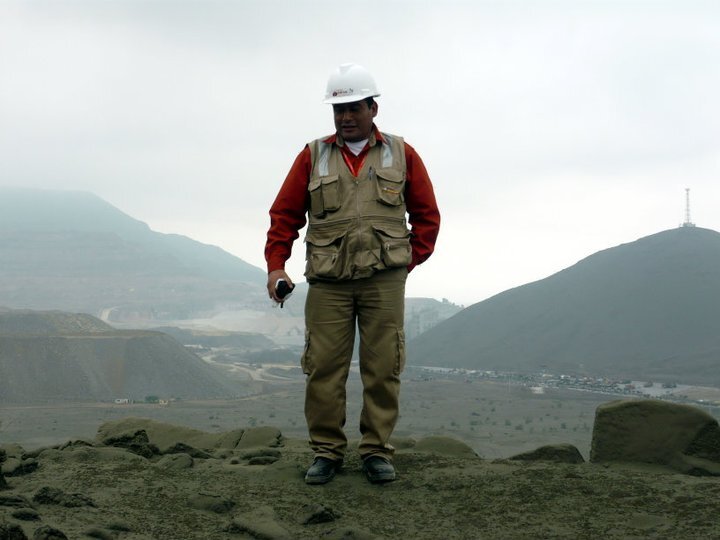 Project Co-Director Jeisen Navarro Veiga
Project Co-Director Jeisen Navarro Veiga
Jeisen Navarro has 20 years of experience working in northern Peru and is a member of the Registro Nacional de Arqueológos del Perú (RNA). He has co-directed dozens of projects and was most recently co-director of the Samanco archaeological project in the Coastal Nepeña Valley.
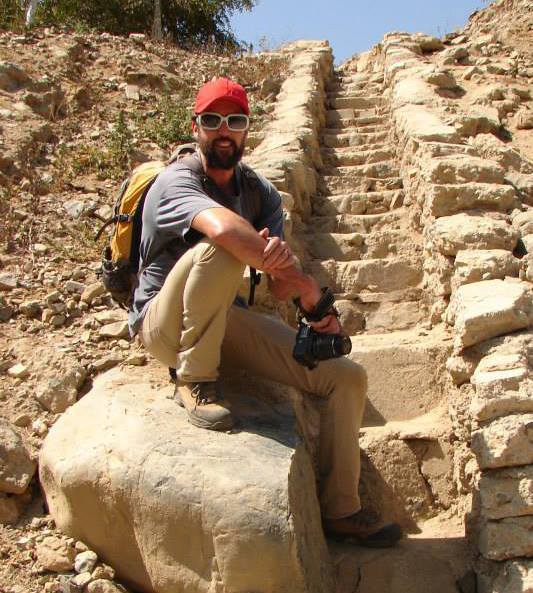 Project Advisor Dr. David Chicoine
Project Advisor Dr. David Chicoine
Dr. David Chicoine is an Assistant Professor at Louisiana State University. He earned his PhD from the University of East Anglia in 2007. Chicoine has over 10 years of experience working on the Peruvian north coast and has a long term research project at the site of Caylán, in the lower Nepeña Valley. His research has focused on the design and use of architectural spaces, modes of social interactions, foodways, funerary practices, visual arts, religious symbolism, and marine exploitation. Dr. Chicoine will be advising on the project, and all university credits for the field school will be offered and overseen by him.
Above images courtesy Cosma Archaeological Project
Travel and learn with Far Horizons.
Read about the most fascinating discoveries with a premium subscription to Popular Archaeology Magazine. Find out what Popular Archaeology Magazine is all about. AND MORE:
On the go? Get the smartphone version of Popular Archaeology as an app or as an ebook.
Popular Archaeology’s annual Discovery Edition eBook is a selection of the best stories published in Popular Archaeology Magazine in past issues, with an emphasis on some of the most significant, groundbreaking, or fascinating discoveries in the fields of archaeology and paleoanthropology and related fields. At least some of the articles have been updated or revised specifically for the Discovery edition. We can confidently say that there is no other single issue of an archaeology-related magazine, paper print or online, that contains as much major feature article content as this one. The latest issue, volume 2, has just been released. Go to the Discovery edition page for more information.

